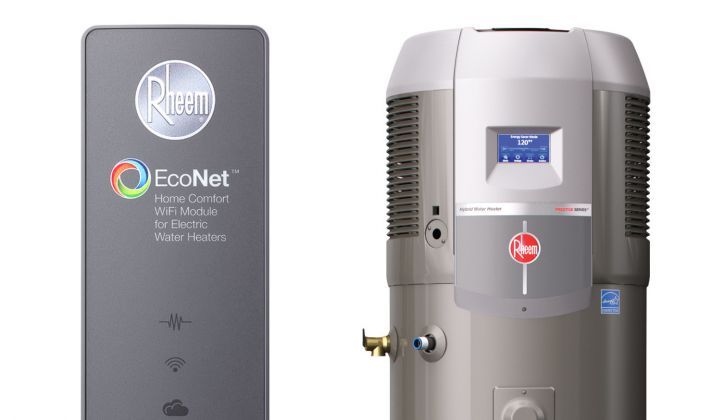There’s a debate over the role of water heaters as grid edge resources.
In one camp are the water heater vendors and utilities — most but not all of them rural electric cooperatives — interested in expanding the already massive fleet of electric water heaters being used for simple demand response to a much broader range of flexible grid services.
In the other camp are those who say that utilities and homeowners should focus instead on replacing electric resistance water heaters with heat pump water heaters. For most climates, they’re a much more efficient way to use electricity to heat water. But by this very virtue, they offer a lot less flexibility to utilities, grid operators, or the customers that own them, in terms of responding to grid needs.
This week, distributed energy platform provider EnergyHub, smart heat pump water heater maker Rheem, and Connecticut utility United Illuminated unveiled the results of a real-world pilot project that shows utilities can have the best of both worlds — if the technologies and programs are aligned properly.
The pilot is part of UI’s low-income Home Energy Solutions-Income Eligible program, which offers a range of efficiency audits, services and low or no-cost retrofits to participants. That list has for some time included wi-fi connected smart thermostats through UI’s bring-your-own-thermostat (BYOT) program run on EnergyHub’s cloud platform, dubbed Mercury.
Last year, UI and EnergyHub launched a new offering — a free Rheem heat pump water heater, as long as the customer agreed to allow the utility to control it during key hours, primarily winter mornings and evenings. These are the hours when grid operator ISO New England faces the greatest threat of rising energy demand for heating coincide with dropping generation supply from power plants being forced offline by cold weather. That's the combination of conditions that has led to the “polar vortex” events of the past decade.
Over the course of last winter, UI and EnergyHub successfully predicted, scheduled and dispatched a series of demand response calls to those Rheem heat pump water heaters, essentially turning them off for as long as possible, before the water gets too cold.
“The main idea is that the customer will never notice” that the water temperature has changed, Chris Ashley, EnergyHub’s vice president of utility sales, said in a Monday interview. “You’re just shifting the energy usage to a different time.”
In and of itself, this isn’t particularly noteworthy. According to the National Rural Electric Cooperative Association (NRECA), rural co-ops save about 500 megawatts per year in water heater DR programs across 35 states. To be sure, this is largely through one-way pager networks with severely limited flexibility. But the next wave is expected to be enabled by two-way broadband-to-wi-fi connectivity, as with notable pilot projects in Hawaii, the Pacific Northwest, and Canada’s maritime provinces.
Still, there’s no doubt that heat pump water heaters are far more efficient, at least for the climates and home construction types for which they’re suited. This became a central sticking point in federal energy efficiency legislation passed in 2015, ending with a compromise that allowed grid-enabled electric resistance water heaters alongside heat-pump water heaters, along with reporting to ensure those grid-responsive capabilities are being tapped.
But as Ashley noted, the important thing about the UI pilot is that it showed that heat pump water heaters, while much less flexible — i.e., otherwise wasteful — than electric resistance heaters, still have demand response value, just not as much. “Because there is an energy efficiency value of the heat pump water heaters, by definition it degrades the demand response value,” he said.
That’s OK, though, because UI’s program isn’t just paying for itself by maximizing its demand response value. It’s also providing big efficiency gains — up to 50 percent compared to the water heaters it’s replacing, on average — that help the utility meet its state-mandated energy conservation and low-income assistance goals.
EnergyHub, which is owned by Alarm.com, has incorporated "smart" water heaters alongside other devices of different types and from different vendors through its cloud platform via application programming interfaces (APIs). That allows it to avoid the pitfalls of trying to manage multiple distributed energy resources (DERs) from separate silos, or relying on slow-to-change and vendor-specific communications protocols to network devices in homes and businesses themselves.
“Doing API integration allows for more robust and flexible control than some of the standards that are out there,” Ashley said.
The same facts are driving the proliferation of APIs and developer big home automation and energy management platform providers like Google’s Nest, Amazon’s Alexa, Apple, Samsung and others, both to expand the services and support the relationships they have with their mass-market residential customers, and to offer for utilities with which they’ve formed specific partnerships.
EnergyHub’s platform is also integrating DERs such as rooftop solar inverters and behind-the-meter batteries, Ashley noted.
Its pilot project with Arizona Public Service, launched in November 2018, is integrating smart thermostats, water heaters and BTM storage in an effort to both decrease peak late afternoon and evening demand and actually increase load during midday solar peaks.
And customer National Grid, which is using EnergyHub’s platform for its multi-state bring-your-own-device (BYOD) program, dubbed Connected Home Solutions, last year added BTM batteries to the list of devices it can support.




